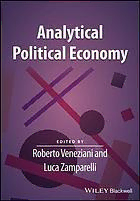
Analytical political economy PDF
Preview Analytical political economy
Analytical Political Economy Analytical Political Economy Edited by Roberto Veneziani and Luca Zamparelli Thiseditionfirstpublished2018 Chapters© 2018TheAuthors Bookcompilation© 2018JohnWiley&SonsLtd OriginallypublishedasaspecialissueoftheJournalofEconomicSurveys(Volume31,Issue5) BlackwellPublishingwasacquiredbyJohnWiley&SonsinFebruary2007.Blackwell’spublishingprogramhas beenmergedwithWiley’sglobalScientific,Technical,andMedicalbusinesstoformWiley-Blackwell. RegisteredOffices JohnWiley&Sons,Inc.,111RiverStreet,Hoboken,NJ07030,USA JohnWiley&SonsLtd,TheAtrium,SouthernGate,Chichester,WestSussex,PO198SQ,UnitedKingdom EditorialOffice 9600GarsingtonRoad,Oxford,OX42DQ,UK Fordetailsofourglobaleditorialoffices,forcustomerservices,andforinformationabouthowtoapplyfor permissiontoreusethecopyrightmaterialinthisbookpleaseseeourwebsiteatwww.wiley.com/wiley-blackwell. TherightsofRobertoVenezianiandLucaZamparellitobeidentifiedastheauthorsoftheeditorialmaterialinthis workhavebeenassertedinaccordancewiththeUKCopyright,DesignsandPatentsAct1988. Allrightsreserved.Nopartofthispublicationmaybereproduced,storedinaretrievalsystem,ortransmitted,inany formorbyanymeans,electronic,mechanical,photocopying,recordingorotherwise,exceptaspermittedbytheUK Copyright,DesignsandPatentsAct1988,withoutthepriorpermissionofthepublisher. Wileyalsopublishesitsbooksinavarietyofelectronicformats.Somecontentthatappearsinprintmaynotbe availableinelectronicbooks. Designationsusedbycompaniestodistinguishtheirproductsareoftenclaimedastrademarks.Allbrandnamesand productnamesusedinthisbookaretradenames,servicemarks,trademarksorregisteredtrademarksoftheir respectiveowners.Thepublisherisnotassociatedwithanyproductorvendormentionedinthisbook.This publicationisdesignedtoprovideaccurateandauthoritativeinformationinregardtothesubjectmattercovered.Itis soldontheunderstandingthatthepublisherisnotengagedinrenderingprofessionalservices.Ifprofessionaladvice orotherexpertassistanceisrequired,theservicesofacompetentprofessionalshouldbesought. LibraryofCongressCataloging-in-PublicationData Names:Veneziani,Roberto,1972–editor.|Zamparelli,Luca,editor. Title:Analyticalpoliticaleconomy/editedbyRobertoVeneziani,LucaZamparelli. Description:Hoboken:Wiley-Blackwell,2018.|Series:Surveysofrecentresearchineconomics|Includesindex.| Identifiers:LCCN2018006239(print)|LCCN2018010004(ebook)|ISBN9781119483335(pdf)| ISBN9781119483311(epub)|ISBN9781119483366(paperback) Subjects:LCSH:Economics.|Economicpolicy.|Macroeconomics.|BISAC:BUSINESS&ECONOMICS/ Economics/Macroeconomics. Classification:LCCHB171.5(ebook)|LCCHB171.5.A4832018(print)|DDC330–dc23 LCrecordavailableathttps://lccn.loc.gov/2018006239 CoverDesign:Wiley CoverImage:© EvgeniiBobrov/Gettyimages Setin10/12ptTimesbyAptaraInc.,NewDelhi,India 10 9 8 7 6 5 4 3 2 1 ForVandaandBruno.Theyknowexactlywhy. R.V. Tomymother,whomadeitpossible. L.Z. CONTENTS 1. AnalyticalPoliticalEconomy 1 RobertoVenezianiandLucaZamparelli 2. TakingStock:ARigorousModellingofAnimalSpiritsinMacroeconomics 5 ReinerFrankeandFrankWesterhoff 3. TheAgent-BasedApproachtoPostKeynesianMacro-Modeling 39 CorradoDiGuilmi 4. Stock-FlowConsistentMacroeconomicModels:ASurvey 63 MichalisNikiforosandGennaroZezza 5. HeterodoxTheoriesofEconomicGrowthandIncomeDistribution: APartialSurvey 103 AmitavaKrishnaDutt 6. EndogenousTechnicalChangeinAlternativeTheoriesofGrowthand Distribution 139 DanieleTavaniandLucaZamparelli 7. MinskyModels:AStructuredSurvey 175 MariaNikolaidiandEngelbertStockhammer 8. FinancializationandInvestment:ASurveyoftheEmpiricalLiterature 207 LeilaE.Davis 9. QuantitativeEmpiricalResearchinMarxistPoliticalEconomy: ASelectiveReview 237 DeepankarBasu 10. Value,Price,andExploitation:TheLogicoftheTransformationProblem 269 SimonMohunandRobertoVeneziani viii CONTENTS 11. AProgressReportonMarxianEconomicTheory:OntheControversies inExploitationTheorySinceOkishio(1963) 307 NaokiYoshihara 12. South–SouthandNorth–SouthEconomicExchanges:DoesitMatter whoisExchangingWhatandwithWhom? 339 OmarS.DahiandFiratDemir Index 381 1 ANALYTICAL POLITICAL ECONOMY Roberto Veneziani School of Economics and Finance Queen Mary University of London Luca Zamparelli Department of Social and Economic Sciences Sapienza University of Rome Thisspecialissuecollects11surveysonrecentdevelopmentsinAnalyticalPoliticalEconomy. Originallyabranchofmoralphilosophy,politicaleconomyemergedasanautonomousdisci- plineduringtheearlystagesoftheindustrialrevolution,thankstotheanalysesofFrenchphys- iocratsandBritishclassicalpoliticaleconomists.Itcanbelooselydefinedasthesocialscience thatstudiestheproductionanddistributionofwealthinacapitalistmarketeconomy.Aban- donedinfavourofthemoreneutral‘Economics’,nowadaysthetermisstillusedtoindicate approachestoeconomicanalysisthatliebeyondtheboundariesofmainstream,neoclassical analysisrootedintheWalrasiangeneralequilibriumtradition. Contributionsgatheredinthisvolumesurveyawidevarietyoftopicsandbelongtodiffer- entschoolsofthought.Theyaregroupedtogetherastheyallreviewrecentformal,rigorous economicresearch–boththeoreticalandempirical–thatrejectsatleastsomeofthedefining featuresofneoclassicaleconomics;hencethenameAnalyticalPoliticalEconomy. Despitetheheterogeneity,wecanusesomebroadcategoriestodescribethesurveyscom- prisedinthisspecialissue.PapersbyReinerFrankeandFrankWesterhoff,CorradoDiGuilmi, andMichalisNikiforosandGennaroZezzadealwithtopicsbelongingtoKeynesianmacroe- conomics. One of the fundamental claims of Keynes’s analysis is that in a monetary econ- omy there may be no tendency to full employment as investment and saving decisions are taken by different economic actors. In fact, the role of investors’ beliefs, expectations and confidence about the future state of the economy is crucial in determining the equilibrium level of employment and economic activity (Keynes, 1936). Franke and Westerhoff review recentapproachestoformalizeandmodel‘animalspirits’inmacrodynamicmodelsthatex- plicitlyrejecttherationalexpectationhypothesis.Theydosobydevelopingacanonicalframe- workthatisflexibleenoughtoencompasstwowaystomodelattitudestowardoptimismand AnalyticalPoliticalEconomy,FirstEdition.EditedbyRobertoVenezianiandLucaZamparelli. Chapters©2018TheAuthors.Bookcompilation©2018JohnWiley&SonsLtd.Published2018byJohnWiley&SonsLtd. 2 VENEZIANIANDZAMPARELLI pessimism:thediscretechoiceandthetransitionprobabilityapproach,whereindividualagents faceabinarydecisionandchooseoneofthemwithacertainprobability.Theseassessments areadjusted–eitherupwardordownward–inresponsetowhatagentsobserve,whichleads tochangesinaggregatesentimentandthereforeintherelevantmacroeconomicvariables. DiGuilmisurveysthegrowingliteraturesparkedbytherecentcross-fertilizationofagent- basedmodellingandPost-Keynesianmacroeconomics.Hearguesthatagent-basedmodelling isfullyconsistentwiththePost-Keynesianapproachandthatbothareasofresearchcanbene- fitfrommutualengagement.Thesurveydiscusseshowvariousmodelshavesolvedtheissues raised by the adoption of the bottom-up approach typical of agent-based models in a tradi- tionally aggregative structure and highlights the novel insights derived from this modelling strategy.Thepapersreviewedaregroupedintofourdifferentcategories:agent-basedmodels thatformalizeHymanMinsky’s‘FinancialInstabilityHypothesis’;evolutionarymodelswith Post-Keynesianfeatures;neo-Kaleckianmodelswithagent-basedfeatures;andStock-Flow- Consistentagent-basedmodels. Stock-Flow-Consistent models are the focus of the analysis developed by Nikiforos and Zezza.TheyfirstillustratethegeneralfeaturesoftheStock-Flow-Consistentapproach,force- fullyshowingthatitisaframeworkcapableofaccountingfortherealandthefinancialsides oftheeconomyinanintegratedway.TheythendiscusshowthecoreStock-Flow-Consistent modelhasbeenrecentlyextendedtoaddressissuessuchasfinancializationandincomedis- tribution,openeconomiesandecologicalmacroeconomics. ThetwopapersbyAmitavaDutt,andDanieleTavaniandLucaZamparellireviewthelatest developmentsinmodelsofgrowthandincomedistribution.Therelationbetweengrowthand distributionhasbeencentralinpoliticaleconomysincetheclassicaleconomists–Smithand Ricardoinparticular–arguedthattheaccumulationofcapitalmustbefinancedbysavingout of profits. The direction of causality has been later inverted by Post-Keynesian economists, whoconsidereddistributionastheadjustingvariable,giventheKeynesianassumptiononthe exogenousnatureofinvestment(seeKurzandSalvadori,1995foranintroductiontothediscus- sion).Bothpapersdevelopunifiedframeworks,which,oncecoupledwithdifferentclosures, can describe Classical-Marxian, Kaleckian, and Post-Keynesian heterodox growth models. Duttextendsthegeneralframeworktoshowhowrecentcontributionshaveenrichedtheorigi- naltheorieswithnewtopicssuchasmoneyandinflation,financeanddebt,multisectorissues, openeconomyandenvironmentalquestions.TavaniandZamparelli,instead,focusonendoge- nous technical change and use the unified structure to compare heterodox and neoclassical modelsofexogenous,semi-endogenousandendogenousgrowth. Thepapers byMariaNikolaidi and Engelbert Stockhammer, andLeila Davisfocus on fi- nanceandthefinancialsector.Minsky’s‘FinancialInstabilityHypothesis’(Minsky,1986)is arguablythemostinfluentialtheoryoffinancialmarketsinnon-mainstreameconomics.Itisa theoryofendogenouscyclesbasedondebtaccumulationbytheprivatesector.Timesofeco- nomicstabilityandprosperitymakeborrowersandlendersprogressivelyunderestimaterisk. Theiroptimismengendersanexcessiveexpansionofcredit,which,eventually,createsfinan- cial bubbles and busts. Minsky’s analysis was mostly qualitative but in the latest decades a numberofscholarshaveformalizedhisintuitionsinmacroeconomictheoreticalmodels. Nikolaidi and Stockhammer review these efforts by distinguishing between models that focus on the dynamics of debt or interest, and models in which asset prices play a key role in the evolution of the economy. Within the first category of models they classify: Kalecki– Minskymodels;Kaldor–Minskymodels;Goodwin–Minskymodels;credit-rationingMinsky models;endogenoustargetdebtratioMinskymodelsandMinsky–Veblenmodels.Withinthe ANALYTICALPOLITICALECONOMY 3 secondcategoryofmodels,theydistinguishbetweentheequitypriceMinskymodelsandthe realestatepriceMinskymodels. TheworkofMinskyisalsocentralintheliteraturediscussedbyDavis.Shesurveystheem- piricalliteraturethathasstudiedtheeffectsofthepost-1980expansionoffinanceinadvanced economies,or‘financialization’,oncapitalaccumulation.Afterintroducingarangeofempir- icalindicatorstodefinewhatisindeedmeantby‘financialization’,sheproposestousethree approaches to categorize the literature on financialization and investment. The first two ap- proachesemphasizerisingincomeflowsbetweennonfinancialcorporationsandfinance:first, growthinnonfinancialcorporations’financialincomesand,second,growthinthepayments ofnonfinancialcorporationstocreditorsandshareholders.Thethirdapproachemphasizesthe mostdevelopedbehaviouralexplanationlinkingfinancializationtoreducedinvestment:share- holdervalueorientation. ThepapersbyDeepankar Basu,SimonMohun andRobertoVeneziani, andNaokiYoshi- harasurveyaratherdifferentstrandofAnalyticalPoliticalEconomy,astheyfocusonrecent advances inMarxianeconomics. Basureviews empirical research inMarxistpolitical econ- omy, focusing in particular on: Marxist national accounts, probabilistic political economy, profitabilityanalysis,andClassical-Marxiantheoriesofgrowthandtechnicalchange.Healso considersrecentempiricalstudiesfocusingontheClassical-Marxiantheoryofrelativeprices andvalues,whichisattheheartoftheothertwosurveys.Thelabourtheoryofvaluestatesthat theeconomicvalueofacommodityisdeterminedbytheamountoflaboursociallynecessary toproduceit(Marx,1867).ItliestraditionallyatthecoreofMarxianeconomicanalysis;and itisatthecentreofinnumerabledisputesaroundtheso-called“transformationproblem,”in- vestigatingtherelationshipbetweenlabourvaluesandprices,andexploitationtheory.Mohun and Veneziani adopt an axiomatic approach to interpret the ‘transformation problem’ as an impossibilityresultforaspecificinterpretationofvaluetheorybasedonspecificassumptions anddefinitions.Theyprovideacomprehensivereviewofrecenttheoreticalliteratureandshow that, contrary to the received wisdom, there are various theoretically sound, empirically rel- evant and logically consistent alternative interpretations of the labour theory of value based ondifferentassumptionsanddefinitions.Yoshiharathoroughlyanalysesthedevelopmentof exploitationtheoryinmathematicalMarxianeconomicsfromthe1970stilltoday,withaspe- cial focus on the controversies surrounding the relation between profits and exploitation in capitalisteconomies,anditsrelevanceforthedefinitionoftheconceptofexploitation. Finally,thepaperbyOmarDahiandFiratDemirfocusesoninternationaltradeanddevelop- menteconomics,andinparticularitanalysesthecost-benefitliteratureonSouth–Southversus South–Northeconomicexchanges.Afterprovidingadiscussiononthedefinitionofthenotions of‘North’and‘South’andofferingastatisticaloverviewofSouth–Southeconomicrelations, thepaperprovidesaframeworkforsituatingtheliteraturebyreviewingthetraditionaltargets ofdevelopmentaswellasthebenefitsanddrawbacksofintegrationintotheglobaleconomy inbothSouth–SouthandNorth–Southdirections. References Marx,K.(1867[1977])Capital.ACritiqueofPoliticalEconomy,Vol.I.London:Penguin. Minsky,H.P.(1986)StabilizinganUnstableEconomy.NewHaven:YaleUniversityPress. Keynes,J.M.(1936)TheGeneralTheoryofEmployment,Interest,andMoney.London:Macmillan. Kurz, H. and Salvadori, N. (1995) Theory of Production: A Long-Period Analysis. Cambridge: CambridgeUniversityPress. 2 TAKING STOCK: A RIGOROUS MODELLING OF ANIMAL SPIRITS IN MACROECONOMICS Reiner Franke University of Kiel (GER) Frank Westerhoff University of Bamberg (GER) 1. Introduction Akeyissueinwhichheterodoxmacroeconomictheorydiffersfromtheorthodoxyisthenotion of expectations, where it determinedly abjures the rational expectations hypothesis. Instead, to emphasize its view of a constantly changing world with its fundamental uncertainty, het- erodoxeconomistsfrequentlyrefertothefamousideaofthe‘animalspirits’.Thisisauseful keywordthatposesnoparticularproblemsingeneralconceptualdiscussions.However,given the enigma surrounding the expression, what can it mean when it comes to rigorous formal modelling?Moreoftenthannot,authorsgarlandtheirmodelwiththisword,eveniftheremay beonlylooseconnectionstoit.Thepresentsurveyfocussesonheterodoxapproachesthattake thenotionofthe‘animalspirits’moreseriouslyand,seekingtolearnmoreaboutitseconomic significance,attempttodesigndynamicmodelsthatareabletodefinitivelycapturesomeof itscrucialaspects.1 Thebackground ofthetermasitiscommonly referredtoisChapter 12ofKeynes’ Gen- eralTheory,wherehediscussesanotherelementary‘characteristicofhumannature’,namely, ‘thatalargeproportionofourpositiveactivitiesdependonspontaneousoptimismratherthan on a mathematical expectation’ (Keynes, 1936, p. 161). Although the chapter is titled ‘The stateoflong-termexpectation’,Keynesmakesitclearthatheisconcernedwith‘thestateof psychologicalexpectation’(p.147).2 Itisimportanttonotethatthisstatedoesnotariseoutofthebluefromwhimsandmoods; itisnotanimperfectionorplainignoranceofhumandecisionmakers.Ultimately,itisdueto theproblemthatdecisionsresultinginconsequencesthatreachfarintothefuturearenotonly AnalyticalPoliticalEconomy,FirstEdition.EditedbyRobertoVenezianiandLucaZamparelli. Chapters©2018TheAuthors.Bookcompilation©2018JohnWiley&SonsLtd.Published2018byJohnWiley&SonsLtd.
